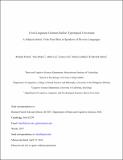| dc.contributor.author | Hickey, Tina | |
| dc.contributor.author | Lee, Aldrin | |
| dc.contributor.author | Lim, Eunice | |
| dc.contributor.author | Luchkina, Elena | |
| dc.contributor.author | Futrell, Richard Landy Jones | |
| dc.contributor.author | Gibson, Edward A | |
| dc.date.accessioned | 2018-01-10T19:14:29Z | |
| dc.date.available | 2018-01-10T19:14:29Z | |
| dc.date.issued | 2014-12 | |
| dc.date.submitted | 2014-11 | |
| dc.identifier.issn | 0010-0277 | |
| dc.identifier.uri | http://hdl.handle.net/1721.1/113049 | |
| dc.description.abstract | In communicating events by gesture, participants create codes that recapitulate the patterns of word order in the world’s vocal languages (Gibson et al., 2013; Goldin-Meadow, So, Ozyurek, & Mylander, 2008; Hall, Mayberry, & Ferreria, 2013; Hall, Ferreira, & Mayberry, 2014; Langus & Nespor, 2010; and others). Participants most often convey simple transitive events using gestures in the order Subject–Object–Verb (SOV), the most common word order in human languages. When there is a possibility of confusion between subject and object, participants use the order Subject–Verb–Object (SVO). This overall pattern has been explained by positing an underlying cognitive preference for subject-initial, verb-final orders, with the verb-medial order SVO order emerging to facilitate robust communication in a noisy channel (Gibson et al., 2013). However, whether the subject-initial and verb-final biases are innate or the result of languages that the participants already know has been unclear, because participants in previous studies all spoke either SVO or SOV languages, which could induce a subject-initial, verb-late bias. Furthermore, the exact manner in which known languages influence gestural orders has been unclear. In this paper we demonstrate that there is a subject-initial and verb-final gesturing bias cross-linguistically by comparing gestures of speakers of SVO languages English and Russian to those of speakers of VSO languages Irish and Tagalog. The findings show that subject-initial and verb-final order emerges even in speakers of verb-initial languages, and that interference from these languages takes the form of occasionally gesturing in VSO order, without an additional bias toward other orders. The results provides further support for the idea that improvised gesture is a window into the pressures shaping language formation, independently of the languages that participants already know. Keywords: Psycholinguistics; Language universals; Language typology; Word order; Gesture; Animacy | en_US |
| dc.language.iso | en_US | |
| dc.publisher | Elsevier | en_US |
| dc.relation.isversionof | https://doi.org/10.1016/j.cognition.2014.11.022 | en_US |
| dc.rights | Creative Commons Attribution-NonCommercial-NoDerivs License | en_US |
| dc.rights.uri | http://creativecommons.org/licenses/by-nc-nd/4.0/ | en_US |
| dc.source | Prof. Gibson via Courtney Crummett | en_US |
| dc.title | Cross-linguistic gestures reflect typological universals: A subject-initial, verb-final bias in speakers of diverse languages | en_US |
| dc.type | Article | en_US |
| dc.identifier.citation | Futrell, Richard, et al. “Cross-Linguistic Gestures Reflect Typological Universals: A Subject-Initial, Verb-Final Bias in Speakers of Diverse Languages.” Cognition, vol. 136, Mar. 2015, pp. 215–21. | en_US |
| dc.contributor.department | Massachusetts Institute of Technology. Department of Brain and Cognitive Sciences | en_US |
| dc.contributor.approver | Gibson, Edward | en_US |
| dc.contributor.mitauthor | Futrell, Richard Landy Jones | |
| dc.contributor.mitauthor | Gibson, Edward A | |
| dc.relation.journal | Cognition | en_US |
| dc.eprint.version | Author's final manuscript | en_US |
| dc.type.uri | http://purl.org/eprint/type/JournalArticle | en_US |
| eprint.status | http://purl.org/eprint/status/PeerReviewed | en_US |
| dspace.orderedauthors | Futrell, Richard; Hickey, Tina; Lee, Aldrin; Lim, Eunice; Luchkina, Elena; Gibson, Edward | en_US |
| dspace.embargo.terms | N | en_US |
| dc.identifier.orcid | https://orcid.org/0000-0002-2656-6139 | |
| dc.identifier.orcid | https://orcid.org/0000-0002-5912-883X | |
| mit.license | PUBLISHER_CC | en_US |
